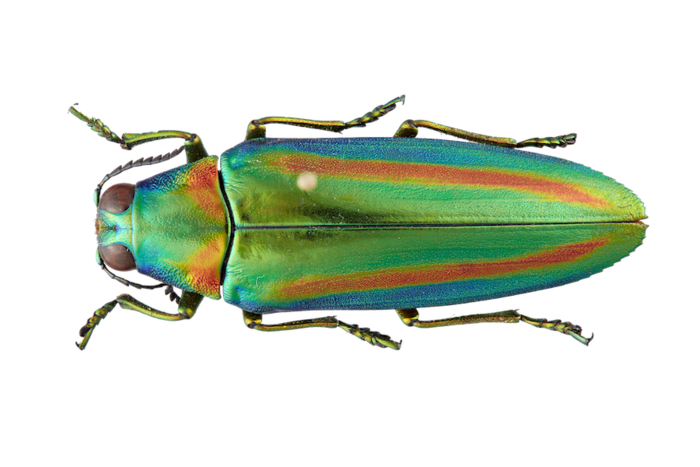Jewel beetles are striking insects, easily recognized by their vivid colors and metallic sheen. Possessing large, well-developed eyes, jewel beetles use vision and color for a range of different behaviors, including finding mates and host plants.
Color vision in insects differs from our own. Special genes allow many insects to see ultraviolet (UV) light as well as blue and green. New research led by Camilla Sharkey, a postdoctoral associate at the Wardill Lab in the College of Biological Sciences, investigated the complex evolutionary history of jewel beetles’ vision. The research team included Jorge Blanco, formerly with the Wardill Lab and now at University of Maryland, Nathan Lord of Louisiana State University, and Trevor Wardill, assistant professor at CBS.
Previous research by Dr. Sharkey has shown that before the evolution of modern beetles, their ancestors lost the ability to see blue light around 300 million years ago. This may have been the result of the beetle ancestor becoming nocturnal or living in low-light conditions. Later, as beetles diversified, they evolved duplicates of the ancestral genes that allow them to see the UV and green spectrum. These duplicate genes could further evolve, making new parts of the color spectrum visible and allowing more complicated and diverse color signals to be seen.
Researchers wanted to know if the duplicate genes have evolved, allowing beetles to see colors that their ancestors could not. Since jewel beetles are difficult to keep in a lab, they copied the genes and inserted them into fruit flies, replacing their normal visual genes. Using electrophysiology, they tested the color sensitivity each gene produced in the flies. They then looked for genetic changes that might underlie the shifts in color sensitivity using 3D protein modeling. The study found that:

Credit: Nathan Lord, Louisiana State University
Jewel beetles are striking insects, easily recognized by their vivid colors and metallic sheen. Possessing large, well-developed eyes, jewel beetles use vision and color for a range of different behaviors, including finding mates and host plants.
Color vision in insects differs from our own. Special genes allow many insects to see ultraviolet (UV) light as well as blue and green. New research led by Camilla Sharkey, a postdoctoral associate at the Wardill Lab in the College of Biological Sciences, investigated the complex evolutionary history of jewel beetles’ vision. The research team included Jorge Blanco, formerly with the Wardill Lab and now at University of Maryland, Nathan Lord of Louisiana State University, and Trevor Wardill, assistant professor at CBS.
Previous research by Dr. Sharkey has shown that before the evolution of modern beetles, their ancestors lost the ability to see blue light around 300 million years ago. This may have been the result of the beetle ancestor becoming nocturnal or living in low-light conditions. Later, as beetles diversified, they evolved duplicates of the ancestral genes that allow them to see the UV and green spectrum. These duplicate genes could further evolve, making new parts of the color spectrum visible and allowing more complicated and diverse color signals to be seen.
Researchers wanted to know if the duplicate genes have evolved, allowing beetles to see colors that their ancestors could not. Since jewel beetles are difficult to keep in a lab, they copied the genes and inserted them into fruit flies, replacing their normal visual genes. Using electrophysiology, they tested the color sensitivity each gene produced in the flies. They then looked for genetic changes that might underlie the shifts in color sensitivity using 3D protein modeling. The study found that:
- Jewel beetles have evolved additional blue and orange sensitivity by duplicating and evolving their UV and green visual genes.
- This enables complex tetra-chromatic color sensitivity to UV, blue, green and orange wavelengths of light, similar to the color sensitivity of colorful birds.
- Newly evolved genetic changes related to color detection were not found to shift sensitivities as predicted when visual genes were modified and retested.
All jewel beetle species studied so far have the four differing gene types that were isolated in the research, suggesting that all jewel beetles probably have complex color sensitivity. According to Sharkey, “the next step is to determine if specific types of color vision can be predicted from genes and how color vision is used by insects to better manage pest and pollinator insects, thus improving crop production.” Researchers also hope to understand the molecular basis of jewel beetle color sensitivity, which would provide a basis for predicting insect color sensitivity from the gene sequence.
Funding was provided by the National Science Foundation and The University of Minnesota College of Biological Sciences. The Wardill Lab is based in the Ecology, Evolution and Behavior Department in CBS.
Journal
Molecular Biology and Evolution
DOI
10.1093/molbev/msad023
Method of Research
Experimental study
Subject of Research
Animals
Article Title
Jewel Beetle Opsin Duplication and Divergence Is the Mechanism for Diverse Spectral Sensitivities
Article Publication Date
31-Jan-2023




